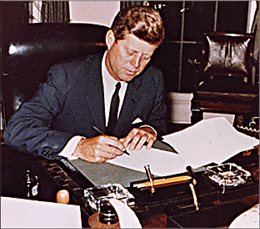
THE REASON FOR AMERICAN INTERVENTION
By 1954 it looked as if Communists might be successful in their oft-stated goal to take over the world. In the years immediately following the end of World War II, Communist governments were installed by Stalin in a number of countries. Germany, defeated in World War II, had been divided by the conquering Allied Powers along the Elbe River in 1945, forming democratic West Germany and Communist East Germany. Meanwhile in Asia, China had fallen to Communism led by Mao Tse-tung. In the Korean War, a three-year conflict that ended in 1953, Communist-ruled North Korea had almost conquered the democratic South Korea. The United States, together with the international peacekeeping organization, the United Nations, came to the rescue of South Korea. Total defeat of North Korea was made impossible when Communist China rushed to the aid of its fellow Communist country. A seesaw battle went on for several months, ending in an uneasy truce in 1953 at the border between South and North Korea.

President John F. Kennedy in the Oval Office signing a proclamation that established a quarantine, which barred American businesses and people from working with or visiting Cuba.
The U.S. concern about the danger of Communist expansion increased in 1959, when Cuba, a Caribbean island-nation less than one hundred miles south of Florida, fell to Communism, led by Fidel Castro. On October 15, 1962, U.S. intelligence learned that the Soviet Union was building nuclear missile launching sites on the island. These areas would target cities and military stations throughout the United States. The American government could not tolerate such a threat, especially so close to American soil. This incident, called the Cuban Missile Crisis, brought the United States and the Soviet Union to the brink of a nuclear war. It was peacefully concluded with the dismantling of these launch sites and an agreement between the United States and the Soviet Union that Cuba would not be supplied with nuclear weapons.
Against this frightening backdrop, the United States government believed that if the Viet Minh took over all of Vietnam, Communism would infiltrate the neighboring nations of Laos, Cambodia, Thailand, and Indonesia, a belief based on the “domino theory.” The U.S. also began to doubt South Vietnam’s ability to defend itself against attack from North Vietnam’s strong army and from Communist guerillas of the National Liberation Front, known as the Viet Cong, located in South Vietnam.
With Cuba as a clear reminder of Communist threat, the stage was set for America’s participation in a war that lasted ten thousand days—the Vietnam War.